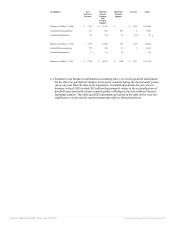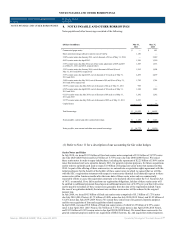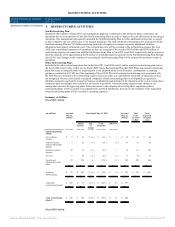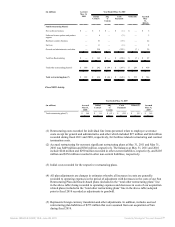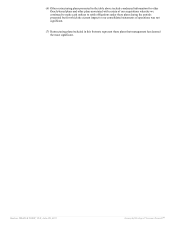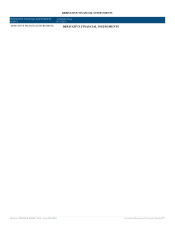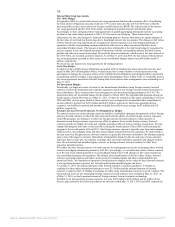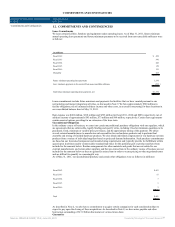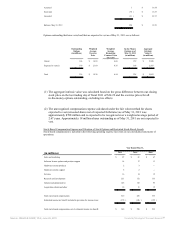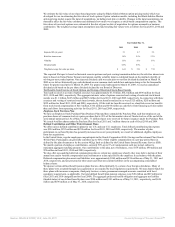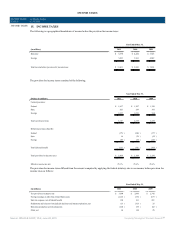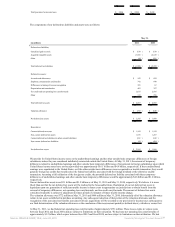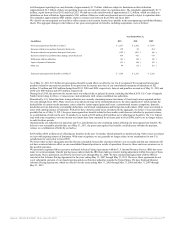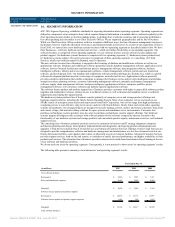Oracle 2010 Annual Report Download - page 191
Download and view the complete annual report
Please find page 191 of the 2010 Oracle annual report below. You can navigate through the pages in the report by either clicking on the pages listed below, or by using the keyword search tool below to find specific information within the annual report.
11.
Interest Rate Swap Agreements
Fair Value Hedges
In September 2009, we entered into interest rate swap agreements that have the economic effect of modifying
the fixed interest obligations associated with our 3.75% senior notes due July 2014 (2014 Notes) so that the
interest payable on these notes effectively became variable based on LIBOR. The critical terms of the interest
rate swap agreements and the 2014 Notes match, including the notional amounts and maturity dates.
Accordingly, we have designated these swap agreements as qualifying hedging instruments and are accounting
for them as fair value hedges pursuant to ASC 815, Derivatives and Hedging. These transactions are
characterized as fair value hedges for financial accounting purposes because they protect us against changes in
the fair value of our fixed rate borrowings due to benchmark interest rate movements. The changes in fair values
of these interest rate swap agreements are recognized as interest expense in our consolidated statements of
operations with the corresponding amounts included in other assets or other non-current liabilities in our
consolidated balance sheets. The amount of net gain (loss) attributable to the risk being hedged is recognized as
interest expense in our consolidated statement of operations with the corresponding amount included in notes
payable and other non-current borrowings. The periodic interest settlements, which occur at the same interval as
the 2014 Notes, are recorded as interest expense. As of May 31, 2011 and 2010, the fair values of these interest
rate swap agreements recorded as other assets in our consolidated balance sheets were $69 million and $33
million, respectively.
We do not use any interest rate swap agreements for trading purposes.
Cash Flow Hedges
In relation to the variable interest obligations associated with our floating rate senior notes that were due and
repaid in May 2010 (Floating Rate Notes), we had entered into certain variable to fixed interest rate swap
agreements to manage the economic effects of the variable interest obligations and designated these agreements
as qualifying cash flow hedges. Upon repayment of the Floating Rate Notes in May 2010, we settled the interest
rate swap agreements associated with the Floating Rate Notes and no other arrangements were outstanding as of
May 31, 2011.
Net Investment Hedges
Periodically, we hedge net assets of certain of our international subsidiaries using foreign currency forward
contracts to offset the translation and economic exposures related to our foreign currency-based investments in
these subsidiaries. These contracts have been designated as net investment hedges pursuant to ASC 815. We
entered into these net investment hedges for the majority of fiscal 2010. We suspended this program during our
fourth quarter of fiscal 2010 and, as of May 31, 2011, we have no contracts of this nature outstanding. For fiscal
2010 and 2009, (losses) gains related to these contracts were recognized to accumulated other comprehensive
income (effective portion) for $(37) million and $(63) million, respectively and to non-operating income
(expense), net (ineffective portion and amount excluded from effectiveness testing) for $1 million and $10
million, respectively.
Foreign Currency Forward Contracts Not Designated as Hedges
We transact business in various foreign currencies and have established a program that primarily utilizes foreign
currency forward contracts to offset the risks associated with the effects of certain foreign currency exposures.
Under this program, our strategy is to enter into foreign currency forward contracts so that increases or
decreases in our foreign currency exposures are offset by gains or losses on the foreign currency forward
contracts in order to mitigate the risks and volatility associated with our foreign currency transactions. We may
suspend this program from time to time and did so during the fourth quarter of fiscal 2010 until resuming the
program in the second quarter of fiscal 2011. Our foreign currency exposures typically arise from intercompany
sublicense fees, intercompany loans and other intercompany transactions that are expected to be cash settled in
the near term. Our foreign currency forward contracts are generally short-term in duration. Our ultimate realized
gain or loss with respect to currency fluctuations will generally depend on the size and type of cross-currency
exposures that we enter into, the currency exchange rates associated with these exposures and changes in those
rates, the net realized and unrealized gains or losses on foreign currency forward contracts to offset these
exposures and other factors.
We neither use these foreign currency forward contracts for trading purposes nor do we designate these forward
contracts as hedging instruments pursuant to ASC 815. Accordingly, we record the fair values of these contracts
as of the end of our reporting period to our consolidated balance sheet with changes in fair values recorded to
our consolidated statement of operations. The balance sheet classification for the fair values of these forward
contracts is prepaid expenses and other current assets for unrealized gains and other current liabilities for
unrealized losses. The statement of operations classification for changes in fair values of these forward contracts
is non-operating income (expense), net, for both realized and unrealized gains and losses.
As of May 31, 2011, the notional amounts of the forward contracts we held to purchase U.S. Dollars in
exchange for other major international currencies were $2.5 billion and the notional amounts of forward
contracts we held to sell U.S. Dollars in exchange for other major international currencies were $1.6 billion. The
net unrealized losses of our outstanding foreign currency forward contracts were nominal at May 31, 2011. As
of May 31, 2010, we had a nominal amount of foreign currency forward contracts outstanding.
Included in our non-operating income (expense), net were $(39) million, $(35) million and $3 million of net
(losses) gains related to these forward contracts for the years ended May 31, 2011, 2010 and 2009, respectively.
Source: ORACLE CORP, 10-K, June 28, 2011 Powered by Morningstar® Document Research℠




